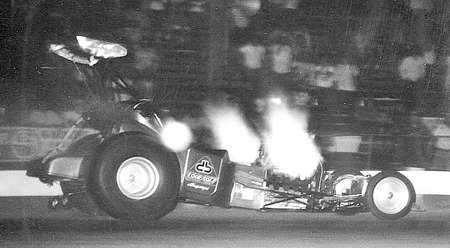 |
||||||||
|
|
 |
|||||||
|
|
|
|||||||
|
Don't take this wrong. I'd pay good cash to see a good modern Fuel Altered show because I'm addicted to anything with a blower, injectors, nitro in the tank and 5-second e.t.s. Easy call. It's just that having grown up in Southern California, the birthplace and the site of the class's golden age, I know what a real Fuel Altered did, how hard they were to handle and the automotive miracle they represented when they ran well. That's what I'm going to attempt to convey below.
For one thing, a modern fan would probably not like the action characterized by the "Wild Willie" Borschs and Dale Emerys of the 1960s and early 1970s. Their cars were vicious, short-tempered beasts and were not designed to produce parity and corporate side-by-side drag racing. If you attended an 8-car show (that's seven actual races in tournament-style eliminations), you might see only three reasonable side-by-side efforts. Why? Because when you shoehorn a fire-breathing, nitro-burning blown, injected iron 392- or 426-cid Chrysler or iron Chevrolet rat into a short stubby roadster or coupe-a car never meant to go anywhere near 200-mph-you have mayhem. These incredibly brave (or nutty) drivers, girded their loins, took a deep breath, and slammed down on a throttle that would produce instant chaos much like a bull ride at a rodeo. The drivers literally hung on for dear life as these wild animals roared down track, blazing the tires, wheelstanding, sashaying wildly, as if they had a mind of their own. So many times, a driver aborted a run rather than risk vaulting the guard rail or somersaulting in a fireball. These were the most difficult drag race cars to drive of all-time. A BIT OF HISTORY For most likely economic reasons (most of the drag racing industry was located there), Southern California's drag racing landscape began to sport a healthy blown roadster and coupe population in the very early 1960s. They didn't all run nitro; some gas and some alcohol users were in the ranks, too. In addition to Golden Staters learning the joys of wild rides, the Midwest produced pioneer racer greats like Illinois racers Gabby Bleeker and his '38 Austin sedan, John Forstka, the '64 Bakersfield-winning Denison-Arlasky-Knox roadster, and the Wells & Tetrault roadster, Indiana's Robert Wernersbach, and the Iowa-based Powers-Riley-Roshek Fiat. Down South, teams such as Hiem-Butler-Hartong of Little Rock, Arkansas and Texas racers like Wilder & Wilder with their "Blue Thunder" roadster, Raymond Austin, Ernie Lentz, Al Carter's 171-mph roadster, Henry Garner's rear-engine roadster, and the greatest rear-engine roadster of all, the Fisher & Greth/Speed Sport Special could find work |
||||||||
|
|
||||||||

Copyright 2000, Drag Racing Online and Racing Net Source |
||||||||


 Car
and Driver
Car
and Driver Car
Craft
Car
Craft Automobile
Automobile